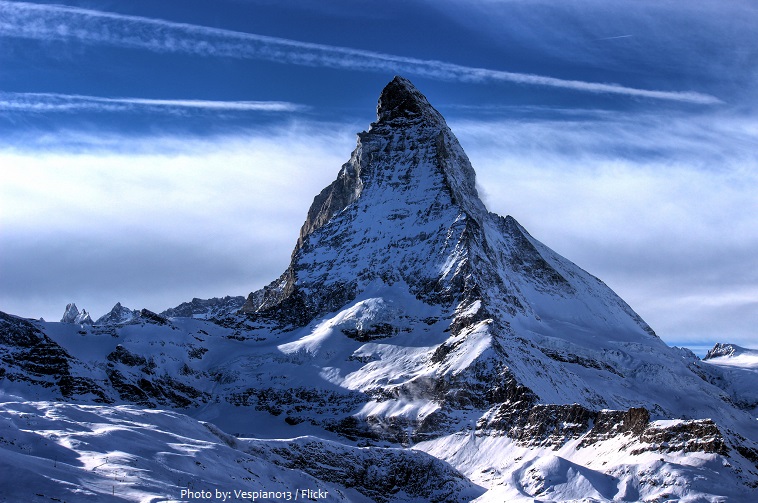
The Matterhorn is a mountain like no other.
At 14,692 feet, it’s hardly the tallest peak in the world. In fact, it’s only the 12th highest summit in the Alps, and barely cracks the global list of the top 400.
But the Matterhorn is hands-down the most photographed peak on the planet, not least because of its striking resemblance to a gigantic fang – and the fact that the Matterhorn Bobsled ride dominates the landscape of Disneyland. Standing all by itself on the border of Switzerland and Italy, the mountain generates its own local weather.
For centuries, it was widely assumed that the Matterhorn could never be climbed.
Its four sheer “faces” – one each pointing toward the north, south, east, and west – are frequently coated with treacherous ice.
Historically, Europeans kept their distance from snow-capped mountains. Even highly educated people, right up to the 1800s, believed that Alpine peaks were the haunts of demons and dragons. When Mont Blanc, Europe’s highest peak, was scaled for the first time in 1786, no evil spirits were found. That kicked off the Golden Age of Mountaineering. Hardy young men – and a surprising number of women – dedicated themselves to conquering every summit.
The Matterhorn proved daunting.
Beginning in 1857, various expeditions could only add a few hundred feet with each new attempt. Climbers were defeated by blizzards, crevasses, and the underlying suspicion that people were never meant to reach its highest point.
The British mountaineer Edward Whymper turned back seven times. But in July 1865 he and six companions pulled themselves up onto the last snow-covered ridge. “Not a footstep could be seen,” he later wrote. They had arrived at a place where no human had ever stood. It was an extraordinary triumph.
If only the story had ended there.
As they carefully worked their way down, the least experienced climber lost his footing, collecting three others. The quartet plunged over a 4,000-foot precipe to their deaths.
Whymper and his two remaining companions survived. But the glory of their achievement was overshadowed by the tragedy. Every newspaper in England published an editorial calling for the end of mountaineering. Queen Victoria asked the Lord Chamberlain if legislation could be passed to outlaw such risky undertakings.
We can only be glad he had the good sense to say no.
No law, however well-intended, can ever eliminate risk from human life. It’s part and parcel of living in a fallen world.
Larry Laudan, a philosopher of science, has spent decades studying risk management. He has concluded that our society is afflicted by risk-lock – a perspective that tempts all too many of us to believe that since any number of things might go wrong, it would be better not to start a new business, make a new acquaintance, or sample a new flavor of ice cream. Laudan has boiled down his research into 19 principles. The first one pretty much says it all:
Everything is risky.
That includes turning off the alarm clock and staying in bed all day. Eileen Guder points out:
“You can live on bland food so as to avoid an ulcer, drink no tea, coffee, or other stimulants in the name of health, go to bed early, stay away from night life, avoid all controversial subjects so as never to give offense, mind your own business, avoid involvement in other people’s problems, spend money only on necessities and save all you can. You can still break your neck in the bathtub, and it will serve you right.”
But the greatest risk of attempting to live a risk-free life is that you will almost certainly fail to experience the life to which God has called you.
“Follow me,” Jesus said. Or, to put it another way: “I’m inviting you to give up a life you cannot keep in order to gain a life you can never lose.”
This is not to say he is beckoning us to take risks for their own sake. In John Ortberg’s memorable phrase, Jesus is not seeking “bungee-jumping, hang-gliding, day-trading, tornado-chasing Pinto drivers.”
But we are being invited to take the calculated risk of learning, all by ourselves, that he can be trusted. Shrinking from that call is to miss life’s greatest adventure.
Aren’t there any guarantees?
Well, there’s this one: We may fall and we may fail from time to time, sometimes even disastrously.
But we can never stumble beyond God’s ability to set things right.
“Now to him who is able to keep you from falling, and to make you stand without blemish in the presence of his glory with rejoicing, to the only God our Savior, through Jesus Christ our Lord, be glory, majesty, power, and authority, before all time and now and forever. Amen.” (Jude 24-25)
By God’s grace, say Yes to the adventure he is offering you today.
